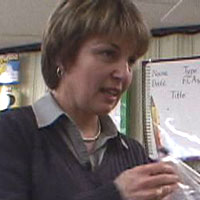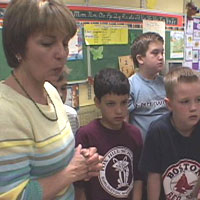Join us for conversations that inspire, recognize, and encourage innovation and best practices in the education profession.
Available on Apple Podcasts, Spotify, Google Podcasts, and more.
 “If kids are going to spend their time learning this material, investigating this material, it’s important that their time be used well, and simply touching on the main ideas or the vocabulary involved doesn’t leave them with any kind of understanding of the topic. In order for me to do that, I need to know what I’m teaching, I need to know the background, and it really has required a fair amount of research on my part, to be able to feel comfortable to field their questions and to be able to give them those big ideas that are important for them to keep when we leave the topic.”
“If kids are going to spend their time learning this material, investigating this material, it’s important that their time be used well, and simply touching on the main ideas or the vocabulary involved doesn’t leave them with any kind of understanding of the topic. In order for me to do that, I need to know what I’m teaching, I need to know the background, and it really has required a fair amount of research on my part, to be able to feel comfortable to field their questions and to be able to give them those big ideas that are important for them to keep when we leave the topic.”
MaryAnn Bernstein teaches third grade at the Fox Hill School in Burlington, MA, an affluent suburb about 20 miles north of Boston. Students at the school consistently score well above state averages on state tests and only 6% of them receive a free or reduced-price lunch. About 88% of the Fox Hill School’s students are white.
In the past several years, state standards in Massachusetts have become more specific and have required teachers to cover new, and often more numerous, topics in science. With less time to spend on each topic, MaryAnn has noticed that she needs to focus carefully on the big or essential ideas in each lesson if her children are to build meaningful understandings.
 Lesson at a Glance:
Lesson at a Glance:
Curriculum: “Causal Patterns in Ecosystems: Lessons to Infuse into Ecosystems Units to Enable Deeper Understandings,” The Understandings of Consequence Project, Project Zero, Harvard Graduate School of Education
Grade: Third
Topic: Causal Patterns in Ecosystems
The activity featured in Session 8 was designed to highlight the role of decomposers in a food web, a concept the class had been working on for some time. The class began the unit by looking first at different global habitats, then at specific habitats. The goal was for the students to recognize that all ecosystems function in the same way even in vastly different habitats – “they were able to understand that even though the Arctic might have polar bears and the rain forest might have toucans, the same patterns and cycles work in both,” explained MaryAnn. From there, the class focused on food chains, then food webs, and finally they looked at the idea of habitats being made up of producers, consumers, and decomposers.
Because most are invisible to the naked eye, decomposers can be difficult for children to understand. At the beginning of the activity, the students reviewed what they already knew about the role of decomposers in the food web. They then completed two activities designed to explore the presence and role of decomposers in a habitat. The first was the worm tank activity. MaryAnn divided the class in half and gave each group a list of materials and directions for putting them into a glass tank. Both tanks contained organic (of living origins) – gummy bears, cereal, bread, etc. – and inorganic (of nonliving origins) materials – sand, plastic lids, etc.
The two tanks were stocked to be as similar as possible, MaryAnn explained, “this is the first time that most students have been exposed to any kind of scientific procedure… so it’s important to teach them that if you want to compare your scientific predictions, you need to be working from a point of consistency.” The class added the last ingredient – worms – to only one of the tanks. MaryAnn explained that she wanted her students to think about cause and effect: “I want them to question and think, I know that the decomposition in the worm tank was caused by the worms. I see decomposition also happening in the other tank, there has to be a cause. I wonder what that is?’”
The second activity was the bread mold activity, in which MaryAnn had each student take a piece of bread, rub it on a frequently used surface inside the school – the floor, a locker, a desk – and then seal it in a plastic bag. In several days, the bread began to mold, with the mold on each piece being somewhat different. “That lets us follow up with a discussion about what other things are out there that might be causing decomposition,” explained MaryAnn.
For this activity, MaryAnn believes the essential concept is for kids to understand decomposition as being part of a cycle so that “they understand that the matter that’s around us doesn’t appear from nowhere, or simply disappear either.”
 Lesson Goals:
Lesson Goals:
Consider the goals for this lesson as listed above. How can you create a lesson appropriate for your classroom that will fulfill similar goals?